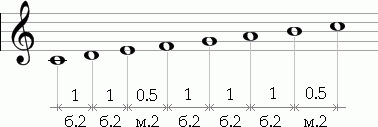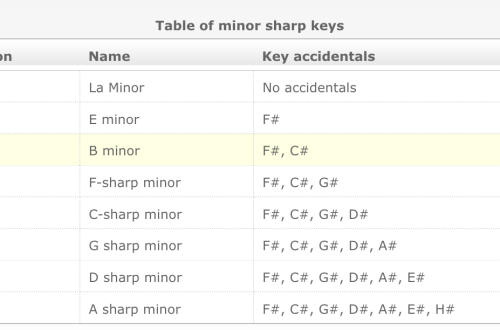
Major scale
Contents
How to create a certain range of sounds that can make music light, joyful?
There is a wide variety of modes in music . By ear, it is easy to distinguish Russian ditties from Georgian songs, oriental music from western, etc. Such a difference in melodies, their moods, is due to the mode used. The major and minor modes are the most widely used. In this chapter, we will look at the major scale.
major scale
Fret , stable sounds of which form a major triad, is called major . Let’s explain right away. A triad is already a chord, we will talk about it a little later, but for now, by a triad we mean 3 sounds, taken either simultaneously or sequentially. A major triad is formed by sounds, the intervals between which are thirds. Between the lower sound and the middle one is a major third (2 tones); between the middle and upper sounds – a small third (1.5 tones). Major triad example:

Figure 1. Major triad
A major triad with a tonic at its base is called a tonic triad.
The major scale consists of seven sounds, which represent a certain sequence of large and small seconds . Let us designate the major second as “b.2”, and the minor second as “m.2”. Then the major scale can be represented as follows: b.2, b.2, m.2, b.2, b.2, b.2, m.2. The sequence of sounds with such an arrangement of steps is called the natural major scale, and the mode is called the natural major. Generally speaking, the scale is called the ordered arrangement of the sounds of the mode in height (from tonic to tonic). The sounds that make up the scale are called steps. Scale steps are indicated by Roman numerals. Do not confuse with the steps of the scale – they have no designations. The figure below shows the numbered steps of the major scale.

Figure 2. Major scale steps
The steps have not only a digital designation, but also an independent naming:
- Stage I: tonic (T);
- Stage II: descending introductory sound;
- Stage III: mediant (middle);
- Stage IV: subdominant (S);
- Stage V: dominant (D);
- Stage VI: submediant (lower mediant);
- Stage VII: rising introductory sound.
Stages I, IV and V are called the main stages. The rest of the steps are secondary. Introductory sounds gravitate towards the tonic (strive for resolution).
Steps I, III and V are stable, they form a tonic triad.
Briefly about the main
So, the major mode is the mode, in which the sequence of sounds forms the following sequence: b.2, b.2, m.2, b.2, b.2, b.2, m.2. Let us recall once again: b.2 – a major second, represents a whole tone: m.2 – a minor second, represents a semitone. The sequence of sounds of a major scale is shown in the figure:

Figure 3. Natural major scale intervals
The figure indicates:
- b.2 – major second (whole tone);
- m.2 – small second (semitone);
- 1 indicates a whole tone. Perhaps this makes the diagram easier to read;
- 0.5 is a semitone.
Results
We got acquainted with the concept of “mode”, analyzed the major mode in detail. Of all the names of the steps, we will most often use the main ones, so their names and locations must be remembered.





